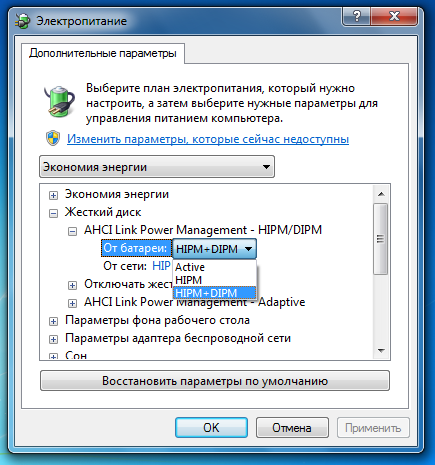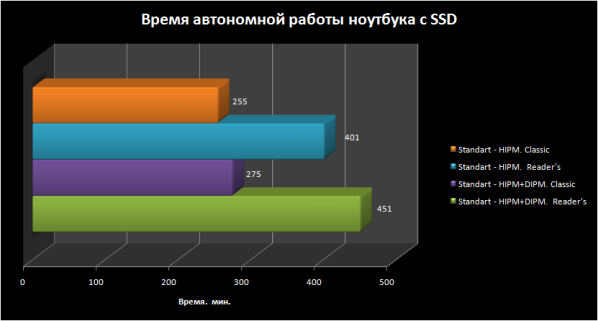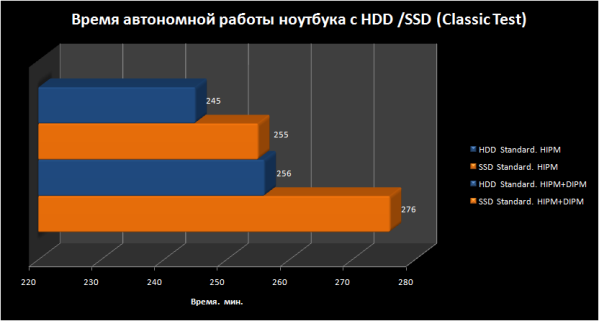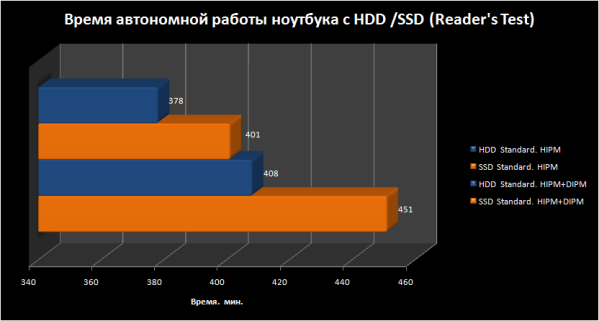What is DIPM for SSDs?
Considering the various characteristics of SSD drives, quite often you can find mention of DIPM in the characteristic of power consumption of solid-state drives. If the SSD is used or planned to be used in desktops, then this value can be ignored, but what if in notebooks and netbooks? Here it all depends on how much you care about the battery life of the mobile device. Well, let's try to understand the question of what DIPM is and why it needs an SSD.
Let's start with the basics - with the Serial ATA (SATA) specification. According to it, SATA controllers should be able to work in two modes: in the native - Advanced Host Controller Interface (AHCI) and compatible with the old Parallel ATA (PATA). The latter, due to the specification, is limited in the possibilities of applying new device functions, therefore, additional opportunities for devices can be obtained using the AHCI mode. In this mode, such functions as NCQ, LPM, Hot Swap, Port Multiplier are available. But we are interested in the LPM function.
The name Link Power Management (LPM) can literally be translated as "Power Management." The function of LPM is as follows: in the absence of data transfer at the physical level between the host controller and the disk, they are converted to low power consumption.
SATA AHCI Link Power Management has two types of control - Host Initiated Link Power Management (HIPM) and Device Initiated Link Power Management (DIPM), which provide two additional device states, in addition to the existing Active - Partial and Slumber.
When in Active state, devices are always ready for I / O. In the Partial state, the host controller in the absence of I / O can put the devices into power-saving mode and then exit it, no more than 10 microseconds. The Slumber state has a deeper power-saving mode than Partial - 10 milliseconds are allocated to exit the power-saving mode. Since the recovery time for Slumber is longer than for Partial, Slumber provides greater system energy savings, while Partial is the balance between performance and energy saving.
Transferring a device to Partial and Slumber can be done either through Host Initiated Link Power Management (HIPM) or Device Initiated Link Power Management (DIPM) - the only difference is how the transition to energy-saving mode is initiated.
Power management initiated by the host controller - HIPM (Host Initiated Link Power Management), can be implemented both in the hardware of the controller and in the software. When using this control, the host controller asks for a transition to energy-saving mode immediately after all requests to the disk are completed, because it is the host controller that is aware of what requests have been or will be sent to the device, this allows you to switch to a low power state immediately after completing all disk requests. It is the host controller that switches the power state.
Device initiated power management — DIPM (Device Initiated Link Power Management) —is implemented by the drive. The disk determines how long it takes to execute the commands, so that upon completion they immediately switch to energy-saving mode.
Each of these types of power management provides energy savings, however, maximum savings are achieved when these two types of control are used together.
The simplified LPM operation scheme, in particular, DIPM management, is presented as follows: after the data transfer to the host controller is completed, the device requests permission to switch to energy-saving mode; the host controller accepts the transition or rejects; if it accepts, it gives the appropriate command to go; transition to the Partial state (for performance reasons); after a period of inactivity, the host controller gives the command to switch the device to the Slumber state (due to the peculiarity of the state switching mechanism, the transition is through an intermediate active state). If the disk is accessed, the controller gives the command to switch to Active.
The practice of using the SATA AHCI Link Power Management function showed a reduction in the power consumption of hard drives from 2-3 W in active state to 0.1-0.7 W in idle mode, and in the case of solid-state drives (SSDs) less than 0.1 W.
At first glance, the SATA AHCI LPM can significantly reduce the power consumption of hard and solid state drives. But will there be significant energy savings for the system as a whole? This can only be determined by testing under typical operating conditions of the system.
A laptop was chosen as a test site (the choice is not accidental, since it is on mobile devices that one can easily detect a decrease in the system’s energy consumption, by increasing the battery life, and this parameter is more informative for the user than the value in watts).
But before moving on to the test result, I wanted to pay attention to a few points. Firstly, the AHCI Link Power Management function is only supported by mobile chipsets (at least Intel chipsets). Secondly, the activation of the DIPM control mode depends on the use of the version of the operating system and driver. Starting with Windows Vista, the operating system already includes a driver for AHCI mode - “Standard AHCI 1.0 Serial ATA Controller”, which provides DIMP support, but in Windows Vista it is disabled by default, and for Windows 7 it is enabled only for power saving mode . AHCI LPM operation mode change is carried out through energy saving settings in the control panel or the console command powercfg.

To determine the battery life of the laptop (Acer TimeLineX) from the battery in the HIPM and HIPM + DIPM modes, the Battery Eater program was used, which was run in the classic test and in read mode, both for the hard drive (TOSHIBA MK1652GSX) and for the solid-state (INTEL SSDSA2M080G2GC) .

The result shows that using the HIPM + DIPM versus HIPM mode for the hard drive also gives a positive result, the laptop’s battery life has increased by 11 and 30 minutes, for the classic test and reading test, respectively.

For a solid state drive, battery life increased by 20 and 50 minutes.

When comparing a solid-state drive with a hard one, by the battery life of a laptop, we get that when replacing a hard drive with a solid-state drive, the battery life of the laptop increased by only 10 minutes for the classic test in AHCI LPM - HIPM mode and by 21 minutes in the mode HIPM + DIPM.

In read mode, the values are more significant 25 and 45 minutes, respectively.
As a result, it turns out that using AHCI LPM in HIPM + DIPM mode is effective not only for a solid-state drive, but for a hard drive, but the maximum result of the laptop’s battery life is achieved using a solid-state drive.
I hope that this entry allowed me to answer the question what is DIPM and what is SSD for.
Let's start with the basics - with the Serial ATA (SATA) specification. According to it, SATA controllers should be able to work in two modes: in the native - Advanced Host Controller Interface (AHCI) and compatible with the old Parallel ATA (PATA). The latter, due to the specification, is limited in the possibilities of applying new device functions, therefore, additional opportunities for devices can be obtained using the AHCI mode. In this mode, such functions as NCQ, LPM, Hot Swap, Port Multiplier are available. But we are interested in the LPM function.
The name Link Power Management (LPM) can literally be translated as "Power Management." The function of LPM is as follows: in the absence of data transfer at the physical level between the host controller and the disk, they are converted to low power consumption.
SATA AHCI Link Power Management has two types of control - Host Initiated Link Power Management (HIPM) and Device Initiated Link Power Management (DIPM), which provide two additional device states, in addition to the existing Active - Partial and Slumber.
When in Active state, devices are always ready for I / O. In the Partial state, the host controller in the absence of I / O can put the devices into power-saving mode and then exit it, no more than 10 microseconds. The Slumber state has a deeper power-saving mode than Partial - 10 milliseconds are allocated to exit the power-saving mode. Since the recovery time for Slumber is longer than for Partial, Slumber provides greater system energy savings, while Partial is the balance between performance and energy saving.
Transferring a device to Partial and Slumber can be done either through Host Initiated Link Power Management (HIPM) or Device Initiated Link Power Management (DIPM) - the only difference is how the transition to energy-saving mode is initiated.
Power management initiated by the host controller - HIPM (Host Initiated Link Power Management), can be implemented both in the hardware of the controller and in the software. When using this control, the host controller asks for a transition to energy-saving mode immediately after all requests to the disk are completed, because it is the host controller that is aware of what requests have been or will be sent to the device, this allows you to switch to a low power state immediately after completing all disk requests. It is the host controller that switches the power state.
Device initiated power management — DIPM (Device Initiated Link Power Management) —is implemented by the drive. The disk determines how long it takes to execute the commands, so that upon completion they immediately switch to energy-saving mode.
Each of these types of power management provides energy savings, however, maximum savings are achieved when these two types of control are used together.
The simplified LPM operation scheme, in particular, DIPM management, is presented as follows: after the data transfer to the host controller is completed, the device requests permission to switch to energy-saving mode; the host controller accepts the transition or rejects; if it accepts, it gives the appropriate command to go; transition to the Partial state (for performance reasons); after a period of inactivity, the host controller gives the command to switch the device to the Slumber state (due to the peculiarity of the state switching mechanism, the transition is through an intermediate active state). If the disk is accessed, the controller gives the command to switch to Active.
The practice of using the SATA AHCI Link Power Management function showed a reduction in the power consumption of hard drives from 2-3 W in active state to 0.1-0.7 W in idle mode, and in the case of solid-state drives (SSDs) less than 0.1 W.
At first glance, the SATA AHCI LPM can significantly reduce the power consumption of hard and solid state drives. But will there be significant energy savings for the system as a whole? This can only be determined by testing under typical operating conditions of the system.
A laptop was chosen as a test site (the choice is not accidental, since it is on mobile devices that one can easily detect a decrease in the system’s energy consumption, by increasing the battery life, and this parameter is more informative for the user than the value in watts).
But before moving on to the test result, I wanted to pay attention to a few points. Firstly, the AHCI Link Power Management function is only supported by mobile chipsets (at least Intel chipsets). Secondly, the activation of the DIPM control mode depends on the use of the version of the operating system and driver. Starting with Windows Vista, the operating system already includes a driver for AHCI mode - “Standard AHCI 1.0 Serial ATA Controller”, which provides DIMP support, but in Windows Vista it is disabled by default, and for Windows 7 it is enabled only for power saving mode . AHCI LPM operation mode change is carried out through energy saving settings in the control panel or the console command powercfg.

To determine the battery life of the laptop (Acer TimeLineX) from the battery in the HIPM and HIPM + DIPM modes, the Battery Eater program was used, which was run in the classic test and in read mode, both for the hard drive (TOSHIBA MK1652GSX) and for the solid-state (INTEL SSDSA2M080G2GC) .

The result shows that using the HIPM + DIPM versus HIPM mode for the hard drive also gives a positive result, the laptop’s battery life has increased by 11 and 30 minutes, for the classic test and reading test, respectively.

For a solid state drive, battery life increased by 20 and 50 minutes.

When comparing a solid-state drive with a hard one, by the battery life of a laptop, we get that when replacing a hard drive with a solid-state drive, the battery life of the laptop increased by only 10 minutes for the classic test in AHCI LPM - HIPM mode and by 21 minutes in the mode HIPM + DIPM.

In read mode, the values are more significant 25 and 45 minutes, respectively.
As a result, it turns out that using AHCI LPM in HIPM + DIPM mode is effective not only for a solid-state drive, but for a hard drive, but the maximum result of the laptop’s battery life is achieved using a solid-state drive.
I hope that this entry allowed me to answer the question what is DIPM and what is SSD for.
